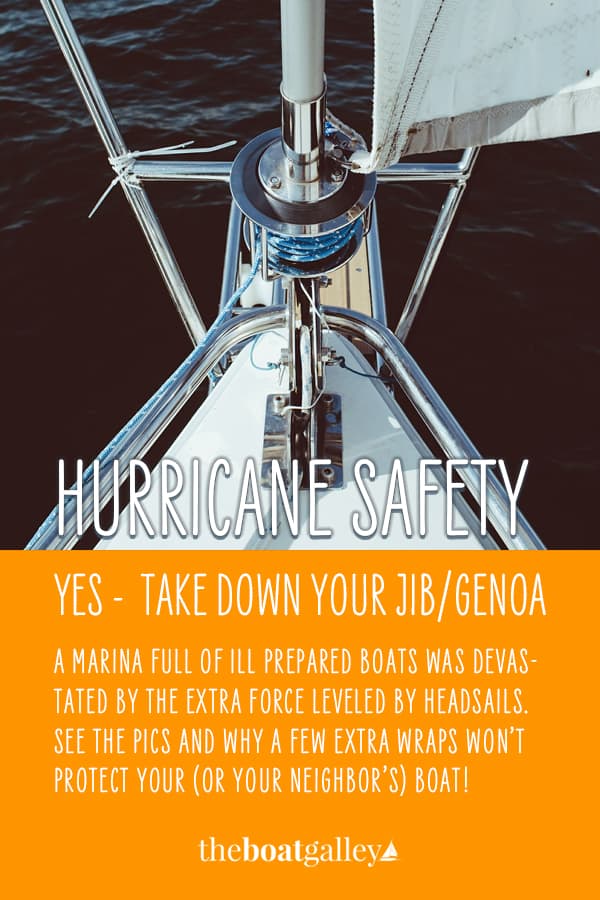
Whenever a hurricane threatens, I post about the need to remove roller furling jobs and genoas. And every time, someone will reply that just tying them off or wrapping with line is sufficient.
It’s not, and the issue isn’t simply possibly ruining your sail.
In 2003, Hurricane Marty raked the Sea of Cortez, where we were cruising. Boaters in the city of La Paz were particularly hard-hit as one marina was literally torn apart in the Category 2 storm (the smaller marina next door also suffered serious damage). Before and after pictures of Marina de La Paz:
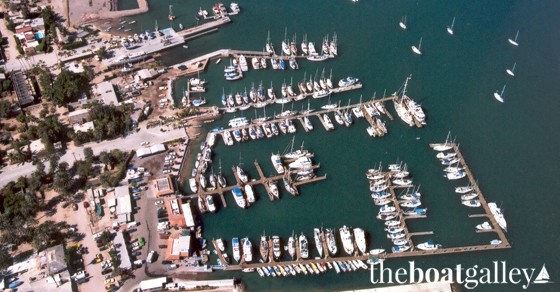
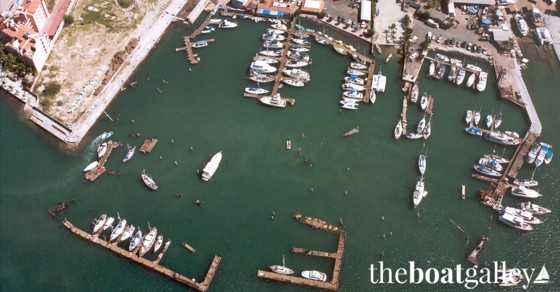
Docks were simply ripped apart in the storm. I’ve seen video taken during the storm and talked to people who were there.
Many boats had been left with roller furling genoas still up — generally tied off in some fashion. The video (which I saw but don’t have — wish I could post it) shows the wind slowing tugging a bit of one of the genoas out of the lines wrapped around it — it started with just a couple inches — and then bit by bit, more pulled out and filling with wind until there was a pouch a couple of feet long. That boat exerted more and more force on the dock and cleats, and finally broke free (it’s not clear from the video if it simply pulled away or actually broke part of the dock).
That boat then crashed into others, which were also having their genoas start to unwrap and fill with air. Bit by bit, more boats broke free or pulled docks apart as the storm raged on. The exact sequence of events is unknown as white-out conditions arrived long before the storm peaked, and cruisers also had to take shelter where there were no windows.
Photos taken afterward show almost all the jibs and genoas hanging in tatters. In some cases, you can see lines wrapped around the sail above and below the portion that was pulled out. In other cases, lines simply chafed through and only remnants were found.
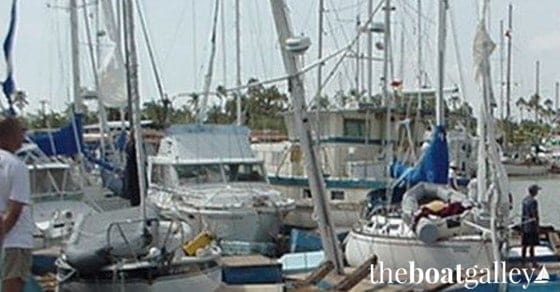
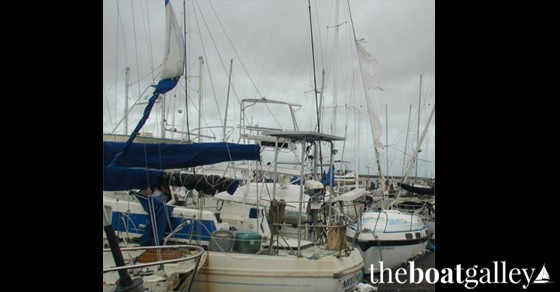
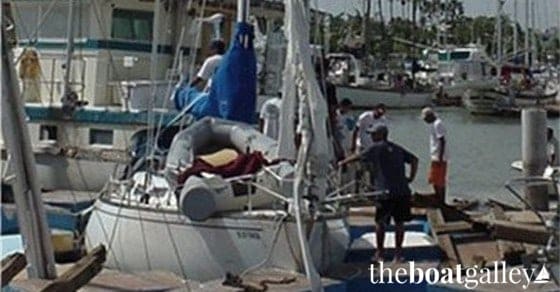
I’m certainly not going to say that there would have been no damage if all boats had been completely stripped before the storm. There might have been.
But I — and everyone that I know who was on scene — am convinced that the roller furling jibs and genoas being left on significantly increased the damage as they multiplied the force that the boats exerted on the docks . . . and also caused harder collisions when boats that had broken free crashed into neighbors.
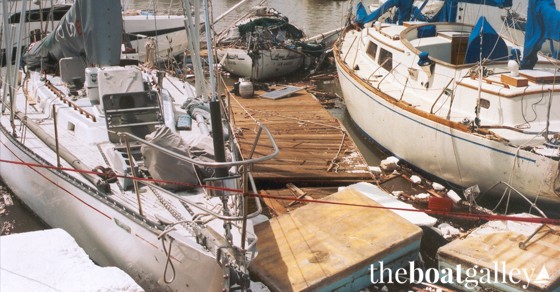
I will say that having had one direct hit by a hurricane and being within 50 miles of the eye on four other occasions, trouble tends to multiply. Once one boat gets in trouble, it’s likely to hit another or snag its anchor. I refer to it as “it takes a village” — whether you are in a marina, anchorage or in the mangroves, you’ll fare best if you help your neighbors after you’ve prepped your boat. Making sure that they are secure and have removed their sails isn’t just helping them, it’s helping yourself.
When a sudden squall pops up, wrapping your roller furling sail and tying it off is usually the best thing you can do. But a hurricane is different. It is likely to be stronger than any squall you’ve been in. It is likely to last far longer than any squall — even if it hits you as a tropical storm and not a full-on hurricane. And you have far more warning than with a squall, so you can prepare better. What works with a squall simply isn’t sufficient for a hurricane.
And if I haven’t convinced you yet of the need to remove the sails, there’s always this reason: Most insurance companies will deny claims if you left sails on, particularly roller furling ones.
More on Hurricane Prep
Learn clear, actionable steps to plan ahead and protect your boat with confidence this hurricane season.
Get Hurricane Ready

Carolyn Shearlock has lived aboard full-time for 17 years, splitting her time between a Tayana 37 monohull and a Gemini 105 catamaran. She’s cruised over 14,000 miles, from Pacific Mexico and Central America to Florida and the Bahamas, gaining firsthand experience with the joys and challenges of life on the water.
Through The Boat Galley, Carolyn has helped thousands of people explore, prepare for, and enjoy life afloat. She shares her expertise as an instructor at Cruisers University, in leading boating publications, and through her bestselling book, The Boat Galley Cookbook. She is passionate about helping others embark on their liveaboard journey—making life on the water simpler, safer, and more enjoyable.




Terry Bogart says
Once you’ve been through one, common sense!!
The Boat Galley says
But when it’s your first . . .
Terry Bogart says
Yes, can GET pricey when you realize what you should have done. 😁
Brittany Mcmanus says
Richard Scott Howerton
Ernie lorimer says
Not just in hurricanes, but any sustained blow., even high 30s and 40s for a few hours. Also, roller furling sails that are free set, like screachers, can chafe through the halyard at the mast and shouldn’t be left up. And the sails can do considerable damage to anything on the front of the mast.
Ward Schmidt says
Video taken at La Paz during hurricane Marty: https://www.youtube.com/watch?v=9wyzlZdTiHo
Thank you for a very informative and important post. Living in Japan with many typhoons, but far enough East and North that our area doesn’t usually get the full force, I am sorry to admit I’ve gotten much too lax about preparation for storms. This post brings home the reality of what can happen and highlights the fact that damage is largely preventable.
Anonymous says
This is important to do anytime you leave the boat for an extended period of time that won’t allow you to return to remove sails, etc. when high winds are forecast. This winter on Martha’s Vineyard we had 4 very strong nor’easters. Mains and jibs were shredded!
The Boat Galley says
YES! And before they are shredded, they can cause dock lines to break or even tear docks apart . . .
Lynn O says
Lost our jib in hurricane Matthew in Titusville in 16. We were novice and left the canvas and sails on having owned the boat for 6 months. Replaced all the canvas (it was 13 yo and had seen its best days-the storm was the final straw) and finally the sail this past year-it coincindentially arrived on our doorstep the day we evacuated for Irma.
All canvas now comes off!